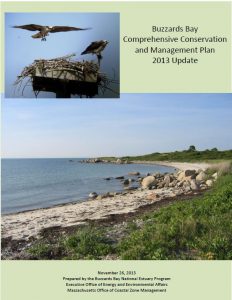The Buzzards Bay NEP and CCMP: Then and Now
About the new Buzzards Bay CCMP Action Plans
The Buzzards Bay Comprehensive Conservation and Management Plan (CCMP) was updated in November 2013 to reflect the great progress achieved since the original CCMP was finalized.
You can download the entire document (buzzards-bay-ccmp-2013-update.pdf) or just this chapter.
This page has only a portion of the text of this chapter. Read the Chapter 1 as a pdf file with graphics.
The Buzzards Bay NEP and CCMP: Then and Now
Program and Management Plan Origins
In 1984, the U.S. Congress designated Buzzards Bay an Estuary of National Significance, one of four estuaries so designated . This designation would establish a watershed program in each of these estuaries comparable to the successful Chesapeake Bay Program, created in 1983. In 1984, the U.S. Congress provided funding to establish the Buzzards Bay Project to develop management recommendations that would preserve and protect water quality and living resources in Buzzards Bay. In 1985, the U.S. EPA and Commonwealth of Massachusetts jointly created the Buzzards Bay Project.
The 1984 Act of Congress would eventually evolve into the National Estuary Program within Section 320 of the reauthorized Clean Water Act of 1987 . In January 1988, the U.S. EPA formally designated the Buzzards Bay Project as a National Estuary Program. Today the Buzzards Bay NEP is one of 28 such programs in the United States.
The original management structure of the Buzzards Bay Project included a Policy Committee composed of the state Environmental Secretary and EPA Regional Administrator who were jointly responsible for overseeing and implementing a federal cooperative agreement that supported the NEP. A Management Committee more directly oversaw the program. This committee was composed of state, federal, and local officials, citizen groups, and others. Subcommittees to the Management Committee included a Citizen Advisory Committee, a Technical Advisory Committee, and a Management Plan Advisory Committee.
Under this management structure, between 1985 and 1990, the Buzzards Bay Project funded water quality and living resource characterizations and assessments of Buzzards Bay. Based on those findings, the program identified management options to address the identified problems, and conducted financial assessments of these solutions. With feedback from the public and state and local government, the Buzzards Bay Project drafted the Buzzards Bay Comprehensive Conservation and Management Plan (CCMP) in 1989, the first NEP to do so. Massachusetts Governor William Weld approved this Management Plan in September 1991, and in April 1992, the U.S. EPA approved it.
The Buzzards Bay CCMP was one of the country’s first coastal watershed plans, and one of the first to focus so strongly on nonpoint source pollution and the cumulative impacts of development on water quality and living resources. Moreover, the plan did not focus exclusively on the quality or the longterm protection of Buzzards Bay waters–it also recognized that the protection of freshwater wetlands and inland habitat throughout the watershed (Figure 1) was vital and better land use decisions and improved management of development impacts were important parts of a holistic watershed protection strategy. The 1991 CCMP also included a Buzzards Bay Action Compact, signed by the member towns of the Buzzards Bay Advisory Committee (latter calling itself the Buzzards Bay Action Committee), a NEP subcommittee composed of municipal officials, and letters of commitment from key federal and state agencies supporting the management plan goals.
The Buzzards Bay CCMP broke much new ground including an innovative coastal nitrogen management strategy that led to the adoption of later TMDL strategies, and it was the first CCMP to address increased sea level rise from climate change. The Buzzards Bay CCMP was also innovative in its focus on support of local government. In fact, nearly three quarters of the 119 recommendations contained in the 1991 CCMP focused on local government action. This focus on local government was a reflection of Massachusetts’ environmental regulatory framework, particularly the “home rule” laws, which empower municipal government, more than any other level of government, with the greatest authority to address the cumulative impacts of nonpoint source pollution and of growth.
Program Restructuring and New Focus
… etc. for all the text and graphics, read the Chapter 1 as a pdf file (317 kb).
